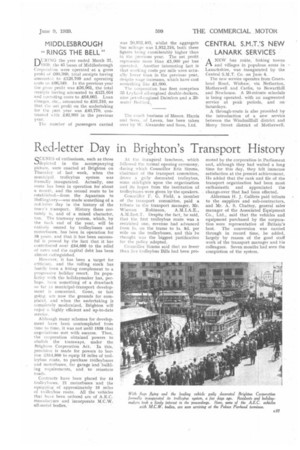Red-letter Day in Brighton's Transport History
Page 55

If you've noticed an error in this article please click here to report it so we can fix it.
SCENF.S of enthusiasm, such as those depieted in the accompanying picture, were enacted at Brighton on Thursday of last week, when the municipal trolleybus system was formally inaugurated. Actually, one route has been in operation for about a month, and the second route to be established—from the Aquarium to liollinghttry—was made something of a red-Idler day in the history of the town's transport. History there certainly is, and of a mixed character, too. The tramway system, which, by the back end of the year, will be entirely ousted by trolleybuses and motorbuses, has been in operation for 38 years, and that it has been successful is proved by the fact that it has contributed over £34,000 to the relief of rates and the capital debt has been almost extinguished.
However, it has been a target for criticism, and the rolling stock has hardly been a fitting complement to a progressive holiday resort. Its popularity with the holidaymaker has, perhaps, been something of a drawback so far as municipal-transport development is concerned. Gone, or fast going, are now the grounds for complaint, and when the undertaking is completely modernized, Brighton will enjoy a highly efficient and up-to-date service.
Although many schemes for development have been contemplated from time to time, it was not until 1938 that negotiations met with success. Then, the corporation obtainedpowers to abolish the tramways, under the Brighton Corporation Act. In this, provision is made for powers to borrow £3,54,000 to equip 15 miles of trolleybus route, to purchase trolleybuses and motorbuses, for garage and building requirements, and to reinstate roads.
Contracts have been placed for 44 trolleybuses, 21 motorbuses and the equipping of approximately 10 Miles of trolleybus route. All the vehicles that have been ordered are of A.E.C. manufacture and incorporate M.C.W. all-metal bodies. At thc inaugural luncheon, which followed the formal opening ceremony, during which Councillor Eric Simms, chairman of the transport committee, drove a gaily decorated trolleybus, sonic sidelights upon the organization and its hopes from the institution of trolleybuses were given by the speakers.
Councillor F. G. Field, a member of the transport committee, paid a tribute to the transport manager, Mr.
Wi Liston Robinson, A.M.I.A.E., A.M.Inst.T. Despite the fact, he said, that the first trolleybus route was a restricted one, revenue had advanced from Is. on the trams to Is. 8d. per mile on the trolleybuses, and this he thought was the biggest justification for the policy adopted.
Councillor Simms said that no fewer than five trolleybus Bills had been pro
moted by the corporation in Parliament and, although they had waited a long time for this day, they felt immense satisfaction at the present achievement. He added that the rank and file of the transport organization had been most enthusiastic and appreciated the change-over that had been effected.
Alderman H. J. Galliers paid tribute to the suppliers and sub-contractors, and Mr. A. S. Chattey, general sales manager of the Associated Equipment Co., Ltd., said that the vehicles and equipment purchased by the corporation were representative of Britain's best. The conversion was carried through in record time, he added, largely by reason of the good staff work of the transport manager and his colleagues. Seven months had seen the completion of the system.




















































































